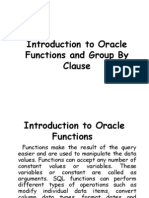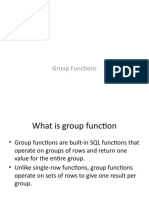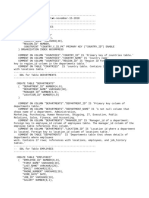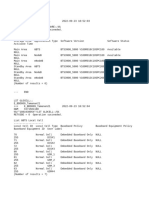Functions In SQL
Ms. Qurat-ul-Ann
1
Functions
• Count
• AVG
• Sum
• MAX
• MIN
• GROUP By Clause
• Having Clause
• Other Clause
2
3
Functions
Functions are used to manipulate data items.
They accepts one or more values and return one value.
An argument is user supplied constant , variable or
column reference .
The FUNCTION NAME (argument1, argument2,……)
4
Aggregate Functions
Aggregate functions generate summary value.
They can be supplied to all the rows in a table or the rows
specified by the WHERE clause.
Aggregate functions generate a single value from set of
rows.
Aggregate functions such as SUM, COUNT, AVG, MAX,
MIN generate a summary value.
5
Count(*)
The count(*) is used to count all rows including rows
containing duplicates and the null values.
Count function is used to count the number of rows.
EAXMPLE
Write a query that displays total columns in EMP table
WHEN DEPTNO=20.
SELECT COUNT(*) FROM EMP WHERE DEPTNO=20;
6
7
Count(Column_Name)
The Count(Column_Name) is used to count the values in
the column specified excluding any null values.
EXAMPLE
Write a query that displays total records in COMM column
of EMP table.
SELECT COUNT (COMM) FROM EMP;
8
Count(Distinct
Column_Name)
The Count(Distinct Column_Name) is used to count all
the rows excluding rows containing duplicates and null
values.
EXAMPLE
Write a query that counts distinct MGR from EMP table.
SELECT COUNT (Distinct MGR) FROM EMP;
9
AVG Function
The AVG function returns the average of all values of the
expression.
AVG Function can be used with numeric column only and
will automatically ignore the null values.
Syntax:
AVG(ALL|DISTINCT] Expression)
ALL: It is the default and is applied to all values
DISTINCT: it indicates that AVG is performed only
one unique instance of a value.
Expression: It is any valid expression like column
name.
10
Example
Write a query that calculated the AVG salary of all
employees.
SELECT AVG(SAL) FROM EMP;
11
Example
Write a query that calculated the DISTINCT AVG salary of
all employees.
SELECT AVG(DISTINCT SAL) FROM EMP;
12
SUM Function
The SUM function returns the sum of all values in an
expression.
It supports the use of DISTINCT to summarize only
unique values in the expression. Null values are ignored.
It can be used only with the numeric columns.
SYNTAX:
Sum(All | DISTINCT] Expression)
13
Example
Write a query that displays the sum of salaries of all clerks
in EMP table.
SELECT SUM(SAL) FROM EMP WHERE JOB=‘CLERK’;
14
MAX Function
The MAX function returns the maximum value in an
expression. It ignores all null values.
It can be used with all data types.
SYNTAX:
MAX(All | DISTINCT] Expression)
15
Example
Write a query that finds the maximum salary earned by
clerk.
SELECT MAX(SAL) FROM EMP WHERE JOB=‘CLERK’;
16
MIN Function
The MIN function returns the minimum value in an
expression. It ignores all null values.
It can be used with all data types.
SYNTAX:
MIN(All | DISTINCT] Expression)
17
Example 1
Write a query that finds the minimum salary
earned by clerk.
SELECT MIN(SAL) FROM EMP WHERE
JOB=‘CLERK’;
18
Example 2
Write a query that finds the minimum, maximum and
average salaries of all employees.
SELECT MIN(SAL), MAX(SAL), AVG(SAL) FROM EMP;
19
GROUP BY Clause
The GROUP BY clause can be used to divide the rows in
a table into smaller group.
If aggregate function is used in SELECT statement,
GROUP BY clause produces a single value per aggregate.
20
Example 1
Write a query that calculates the average salary for each
different job.
SELECT AVG(SAL) FROM EMP GROUPBY JOB;
21
Example 2
Write a query that finds the minimum, maximum salary for
each job type.
SELECT JOB, MAX(SAL), MIN(SAL) FROM EMP
GROUPBY JOB;
22
Excluding Rows in
GROUPBY Clause
Some rows may be pre-excluded in WHERE
clause before dividing them into groups.
23
Example 1
Write a query that displays the average salary for each job
excluding managers.
SELECT JOB, AVG(SAL) FROM EMP WHERE JOB!
=‘MANAGER’ GROUPBY JOB;
24
Groups within Groups
It is also possible to use GROUP BY clause to provide results
for groups within groups.
Write a query that displays average monthly salary for each
job type in department.
SELECT DEPTNO, JOB, AVG(SAL) FROM EMP GROUPBY
DEPTNO, JOB;
25
Having Clause
The HAVING clause is used to filter rows after grouping
them.
It is also used to restrict rows by applying aggregate
function in SELECT statement.
It means the HAVING clause is used to restrict the
groups.
It can be used with all data types.
26
Example 1
Write a query that displays average salary for all
departments employing more than three people.
SELECT DEPTNO, AVG(SAL) FROM EMP GROUPBY
DEPTNO HAVING COUNT(*)>3;
27
Example 2
Write a query that displays those jobs which have maximum
salary greater than 3000.
SELECT MAX(SAL), JOB FROM EMP GROUPBY JOB
HAVING MAX(SAL)>3000;
28
Example 3
Write a query that finds all departments which have more
than 3 employees.
SELECT DEPTNO, COUNT(*) FROM EMP GROUPBY
DEPTNO HAVING COUNT(*)>3;
29
Order of Clauses in
SELECT Statement
The WHERE clause may still be used to exclude rows.
The order of clause is:
SELECT column(s)
FROM table(s)
WHERE row condition(s)
GROUP BY column(s)
HAVING group of rows condition(s)
ORDER BY column(s);
30
Order of Clauses in
SELECT Statement
SQL evaluates:
WHERE clause to establish single rows. It cannot
contain group functions
GROUP BY clause to setup groups.
HAVING clause to select groups for displaying.
31
Exercise
Student
Qurat-ul-Ain 32
Exercise (Cont..)
Write a query to display Maximum cgpa of Students.
Write a query to display Minimum cgpa of Students.
Write a query to display “average Age” of all students.
Write a query to display ‘total cgpa” of all Students.
Write a query to display the highest, lowest and average age
from student table.
Write a query to display total Number of students
Write a query to display total number of students whose city is
distinct.
Write a query to display total number of Students whose
Last_Name is different. Qurat-ul-Ain 33
Exercise (Cont..)
Write a Sql Statement to retrieve no of Students
Write a Sql Statement to retrieve fname, minimum age from
student group by section.
Write a Sql Statement to retrieve lname, maximum cgpa from
student group by city.
Write a Sql Statement to retrieve sid, total age from student
group by degree having total age less than 50
Write a Sql Statement to retrieve Name, average age from
student group by section having average age greater than 50
Qurat-ul-Ain 34
Exercise (Cont..)
Teacher
Qurat-ul-Ain 35
Exercise (Cont..)
Retrieve no. of Teachers in each City
Retrieve Qualification, minimum salary from teacher in each city
Retrieve no. of teacher in each city where city is Rawalpindi
Retrieve qualification, minimum salary from teacher in from distinct
qualification where minimum salary greater than 120500
Retrieve city maximum salary from teacher in each city where
maximum salary less than 120000
Retrieve city, total salary from teacher in each city where total
salary is less than 1900000
Retrieve city, number of teachers from teacher in each city where
number of teacher is greater than 4
Qurat-ul-Ain 36























































































